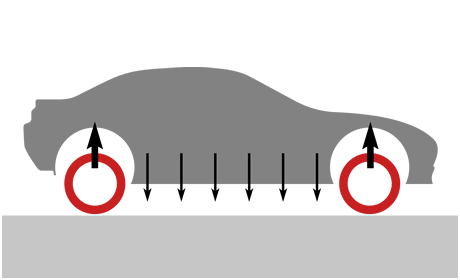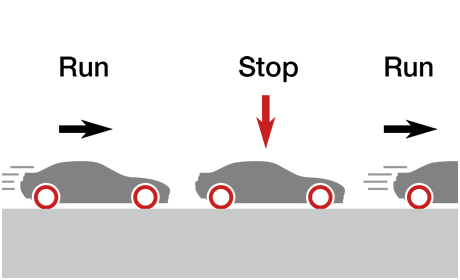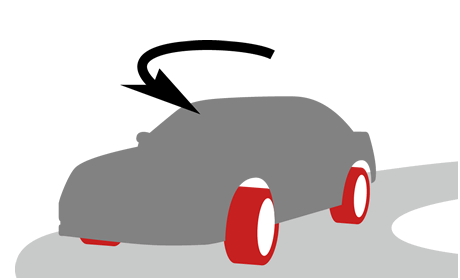TOP > LEARN > Tire Care & Safety > Basic Tire Information
 Tire Care & Safety
Tire Care & Safety
Basic Tire Information
Variety of tire - Categories of the tire types

- Passenger car tires
Passenger car tires meet the needs of the various driving scenarios, including tires for sports cars, luxury sedans, sport utility vehicle(SUV) and winter tire for each vehicle.

- Light truck tires
Light truck tires designed for use by small trucks in delivery and transport operation in urban environments. These tires offer high durability and wear resistance.

- Truck & bus tires
Truck & bus tires meet a wide array of seasonal, surface and other conditions in order to be a force for the logistics of people’s lives.

- Off-the-Road tires
Off-the-road tires are utilized for large-scale machinery at construction and mining and other sites with no roads.
These tires support machinery used at various civil engineering sites with excellent durability and head resistance.
Functions of Tires - 4 Important Functions of Tires

Supporting the weight of your vehicle

Absorbing road shocks

Providing traction and braking

Changing and Maintaining direction of travel
Tire construction

- Tread
- Shoulder
- Belt
- Bead filler
- Bead wire
- Inner liner
- Carcass
- Bead
- Side wall
- Click here for details
-
- Tread
- The tread is the part of a tire that contacts the road surface.
the tread consist of a layer of rubber, compounded to suit the application purpose of the tire, and the thickness serves to protect the belt and carcass. Depending on application a suitable tread pattern is moulded at the time of curing. The tread pattern serves the purpose of improving water drainage, providing traction, braking and cornering characteristics and aiding in NVH performance. - Shoulder
- The shoulder on each side of the tread is designed to protect the belt and carcass of the tire and to disspate heat generated during running to the atmosphere.
- Belt
- The belt is a reinforcement layer extending around the outer circumference of the carcass under the tread. It acts like an iron hoop in improving the stiffness of the tread area.
- Bead filler
- This is a reinforcement rubber that has a triangular cross-section and which is used to increase the stiffness of the bead.
- Bead wire
- A ring-shaped reinforcement material that is made by bundling together several steel wires.
- Inner liner
- The inner liner is a layer of special rubber that has high resistance to air migration.
- Carcass
- The carcass is the load-bearing framework that forms the body of the tire. It is composed of rubber coated fabric laid in a radial direction. The carcass contains the inflation pressure aiding in supporting the load and absorbing impact.
- Bead
- The bead area supports the extremities of the carcass on each side of the tire. This is the part of the tire that anchors the tire to the wheel.
- Side wall
- The sidewall on each side of the tire, between the shoulder and the bead is the section that deflects most during running. The rubber coating serves to protect the carcass.
Tire dimensions
The picture shows where the tire is measured for the tire size code.

- Total width
- Section width(W)
- Section height(H)
- Inside diameter (Rim diameter)
- Outside diameter
- Click here for details
-
- Total width
- The exterior measurement of a tire’s width from inner to outer sidewall (including protective ribs and decorations) when properly mounted and inflated.
- Section width(W)
- The exterior measurement of a tire’s width from sidewall to sidewall (excluding protective ribs or decorations) when properly mounted and inflated, but with no load placed upon the tire.
- Section height(H)
- The measurement of the vertical distance between the tire’s bead seat and outer tread surface when properly mounted and inflated, but with no load placed on the tire.
- Inside diameter (Rim diameter)
- The linear distance between bead seats measured at the widest point. This measurement may be in inches or millimeters.
- Outside diameter
- The linear distance between the tire’s tread surfaces measured at the widest point. This measurement is taken with the tire mounted on the measuring rim and no load applied.
Tire dimensions

- Section width(mm)
- Aspect ratio(%)
- Radial construction
- Rim diameter(inch)
- Load index
- Speed symbol
Load Index(LI)
The capacity of each tire in withstanding the load is referred to as the load capacity. The load index is a numerical code associated with the maximum load a tire can support.
| LI | Kg | LI | Kg |
|---|---|---|---|
| 61 | 257 | 86 | 530 |
| 62 | 265 | 87 | 545 |
| 63 | 272 | 88 | 560 |
| 64 | 280 | 89 | 580 |
| 65 | 290 | 90 | 600 |
| 66 | 300 | 91 | 615 |
| 67 | 307 | 92 | 630 |
| 68 | 315 | 93 | 650 |
| 69 | 325 | 94 | 670 |
| 70 | 335 | 95 | 690 |
| 71 | 345 | 96 | 710 |
| 72 | 355 | 97 | 730 |
| 73 | 365 | 98 | 750 |
| 74 | 375 | 99 | 775 |
| 75 | 387 | 100 | 800 |
| 76 | 400 | 101 | 825 |
| 77 | 412 | 102 | 850 |
| 78 | 425 | 103 | 875 |
| 79 | 437 | 104 | 900 |
| 80 | 450 | 105 | 925 |
| 81 | 462 | 106 | 950 |
| 82 | 475 | 107 | 975 |
| 83 | 487 | 108 | 1000 |
| 84 | 500 | 109 | 1030 |
| 85 | 515 | 110 | 1060 |
| LI | Kg | LI | Kg |
|---|---|---|---|
| 111 | 1090 | 136 | 2240 |
| 112 | 1120 | 137 | 2300 |
| 113 | 1150 | 138 | 2360 |
| 114 | 1180 | 139 | 2430 |
| 115 | 1215 | 140 | 2500 |
| 116 | 1250 | 141 | 2575 |
| 117 | 1285 | 142 | 2650 |
| 118 | 1320 | 143 | 2725 |
| 119 | 1360 | 144 | 2800 |
| 120 | 1400 | 145 | 2900 |
| 121 | 1450 | 146 | 3000 |
| 122 | 1500 | 147 | 3075 |
| 123 | 1550 | 148 | 3150 |
| 124 | 1600 | 149 | 3250 |
| 125 | 1650 | 150 | 3350 |
| 126 | 1700 | 151 | 3450 |
| 127 | 1750 | 152 | 3550 |
| 128 | 1800 | 153 | 3650 |
| 129 | 1850 | 154 | 3750 |
| 130 | 1900 | 155 | 3875 |
| 131 | 1950 | 156 | 4000 |
| 132 | 2000 | 157 | 4125 |
| 133 | 2060 | 158 | 4250 |
| 134 | 2120 | 159 | 4375 |
| 135 | 2180 | 160 | 4500 |
Speed Symbol
The SPEED SYMBOL indicates the maximum speed at which the tire can carry a load corresponding to its Load Index under service conditions specified by the tire manufacturer. (except for speeds above 210km/h, see the above section, “Load capacities and speed limits” respectively for Passenger Cars)
| Speed Symbol | F | G | J | K | L | M | N | P | Q | R | S | T | U | H | V | W | Y | (Y) | ZR |
|---|---|---|---|---|---|---|---|---|---|---|---|---|---|---|---|---|---|---|---|
| Speed (km/h) | 80 | 90 | 100 | 110 | 120 | 130 | 140 | 150 | 160 | 170 | 180 | 190 | 200 | 210 | 240 | 270 | 300 | Over300 | Over240 |
Aspect Ratio
Aspect ratio is the section height expressed as a percentage
of the section width (e.x. 70, 65, 60, etc.).


- Aspect Ratio(%)
- H(Section height)
- W(Section width)
- ×100
- Example
- Overall diameter 205/65R15
- 205×0.65×2
- 15 inch×25.4
- 648mm
- Section height
- Rim dia
- 1inch=25.4mm
- (A) Section width(W)
- (B) Section height(H)

